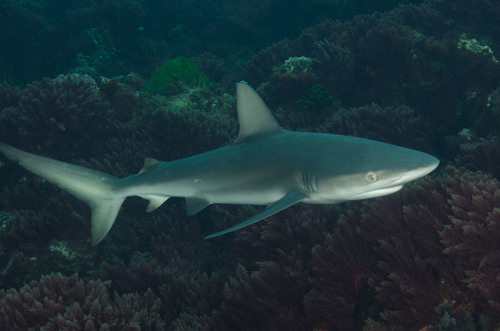
Galapagos Shark
The Bluefin Tuna, a highly migratory species, is one of the ocean's apex predators. Known for their impressive size, speed, and endurance, Bluefin Tuna are vital to marine ecosystems and highly valued in commercial fisheries. This article explores their habitat, appearance, behavior, lifecycle, conservation status, and more.
10 24 years
Lifespan
300 - 350 cm
Length
Near Threatened
Conservation Status
35 km/h
Swimming speed
Carnivorous
Diet
Local Migration
Migration
Appearance Overview
The Bluefin Tuna is renowned for its large, streamlined body, built for speed and endurance in the water.
Color
Dark metallic blue on top with a silvery underside
Fins
Two dorsal fins, the first is depressible; small, yellow finlets run down the back and belly towards the tail
Body Shape
Torpedo-shaped, designed for efficient movement through water
Length
up to 10 feet (3 meters), commonly 6.5 feet (2 meters)
Weight
up to 1,500 lbs (680 kg), commonly 550 lbs (250 kg)
Diet
Carnivorous, feeding on a variety of fish, squid, eels, and crustaceans.
Feeding Behavior
Highly active predators, Bluefin Tuna use their speed and agility to chase down prey. They often hunt in coordinated schools, herding smaller fish into tight formations.
Social Behavior
Highly migratory, forming large schools, especially during spawning. They exhibit complex social behaviors, including cooperative hunting and hierarchical structures within schools
Commercial Relevance
Extremely high value, especially in sushi and sashimi markets, where a single fish can fetch hundreds of thousands of dollars depending on size and quality. It is also important in sport fishing
Conservation measures
International fishing quotas, seasonal fishing closures, minimum size limits, and marine protected areas. Efforts also include tagging programs to monitor populations and migration patterns.
Status
Endangered (Varies by species; Atlantic Bluefin is Endangered, Southern Bluefin is Critically Endangered, Pacific Bluefin is Vulnerable)
Threats
Overfishing is the primary threat, driven by high demand in international markets. Climate change and habitat degradation also impact populations by altering migration routes and prey availability
Habitat Distribution
Depth Range
0-900 meters (0-2,950 feet), commonly found in surface waters but can dive to considerable depths
Geographic Range
Atlantic Ocean, Pacific Ocean, Mediterranean Sea, and the Southern Ocean, depending on the specific species.
Preferred Environment
Temperate and subtropical waters; highly migratory, often following warm currents and prey migrations. Prefers open ocean but can also be found in coastal areas during spawning
Reproduction and Life Cycle
Breeding Habits
Spawns in specific warm water areas, such as the Gulf of Mexico and the Mediterranean Sea. Spawning typically occurs in large aggregations during specific times of the year.
Development Stages
Eggs hatch into larvae that drift with plankton. Juveniles grow rapidly, feeding on small organisms and gradually moving to larger prey as they mature into adults.
Fecundity
Females are highly fecund, capable of producing up to 30 million eggs per spawning season, releasing them into the water for external fertilization.
Maturity Age
Reaches sexual maturity at around 4-8 years for Atlantic Bluefin, earlier for Pacific, and later for Southern Bluefin Tuna.
Faqs about Galapagos Shark
How long do Bluefin Tuna live?
Bluefin Tuna can live up to 40 years, though this varies by species and environmental conditions.
How fast can Bluefin Tuna swim?
Bluefin Tuna are among the fastest fish in the ocean, capable of reaching speeds up to 43 mph (70 km/h) in short bursts.
Are there different types of Bluefin Tuna?
Yes, there are three main species: Atlantic, Pacific, and Southern Bluefin Tuna. Each has unique characteristics and conservation statuses.
What makes Bluefin Tuna unique compared to other tuna species?
Bluefin Tuna are warm-blooded, which is rare among fish. This allows them to maintain a higher body temperature than the surrounding water, aiding in muscle efficiency during high-speed pursuits.
What is being done to protect Bluefin Tuna?
Efforts include strict fishing quotas, seasonal closures, and promoting sustainable fishing practices. Consumers can also help by choosing sustainably sourced seafood and avoiding Bluefin Tuna in markets and restaurants.
Copyright @ Nature Style Limited. All Rights Reserved.
 English
English